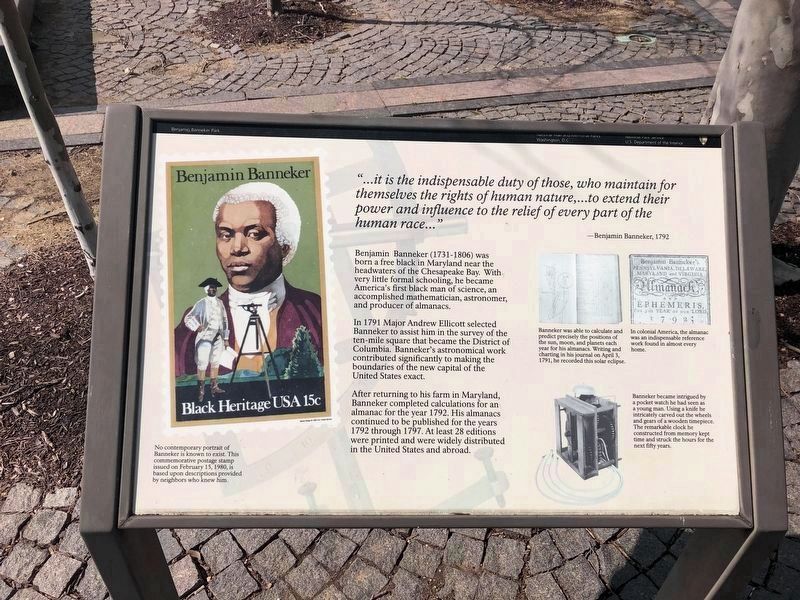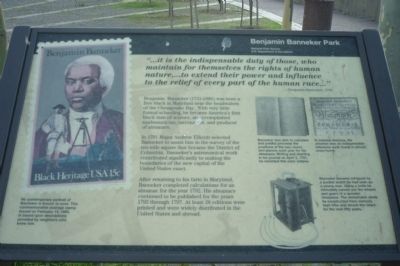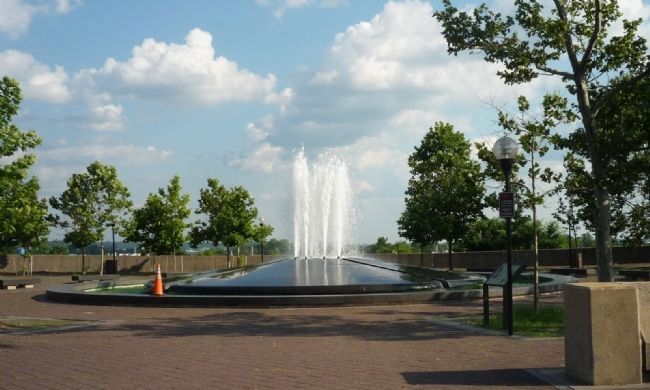Southwest Waterfront in Southwest Washington in Washington, District of Columbia — The American Northeast (Mid-Atlantic)
Benjamin Banneker Park
National Mall and Memorial Parks, Washington, D.C.
— National Park Service, U.S. Department of the Interior —
“… it is the indispensable duty of those, who maintain for themselves the rights of human nature, ... to extend their power and influence to the relief of every part of the human race...”
Benjamin Banneker, 1792
Benjamin Banneker (1731-1806) was born a free black in Maryland near the headwaters of the Chesapeake Bay. With very little formal schooling, he became America’s first black man of science, an accomplished mathematician, astronomer, and producer of almanacs.
In 1791 Major Andrew Ellicott selected Banneker to assist him in the survey of the ten-mile square that became the District of Columbia. Banneker’s astronomical work contributed significantly to making the boundaries of the new capital of the United States exact.
After returning to his farm in Maryland, Banneker completed calculations for an almanac for the year 1792. His almanacs continued to be published for the years 1792 through 1797. At least 28 editions were printed and were widely distributed in the United States and abroad.
Erected by National Park Service, U.S. Department of the Interior.
Topics. This historical marker is listed in these topic lists: African Americans • Science & Medicine. A significant historical year for this entry is 1791.
Location. 38° 52.911′ N, 77° 1.562′ W. Marker is in Southwest Washington in Washington, District of Columbia. It is in Southwest Waterfront. Marker can be reached from L'Enfant Plaza Southwest west of 9th Street Southwest. Marker is on the L'Enfant Promenade at the end of 10th Street, just south of the Southwest Freeway (I-395). It is one block west of the Benjamin Banneker City Park which is situated between 7th and 9th Streets, G Street and Maine Avenue, SW. It is accessible from I-395 via the 7th Street exit. Touch for map. Marker is at or near this postal address: 429 L'Enfant Plaza Southwest, Washington DC 20024, United States of America. Touch for directions.
Other nearby markers. At least 8 other markers are within walking distance of this marker. Banneker Circle: Vista to the Past (a few steps from this marker); Maine Avenue Fish Market (about 300 feet away, measured in a direct line); Annual Oyster Derby (about 500 feet away); High Water Mark DC (about 500 feet away); Potomac River Shoreline (about 600 feet away); Waterfront Commerce (about 600 feet away); The River Queen (about 700 feet away); Abraham Lincoln (about 700 feet away). Touch for a list and map of all markers in Southwest Washington.
More about this marker.
Captions:
[Commemorative U.S. Postage Stamp: “Benjamin Benneker - Black Heritage - USA, 15c”.] No contemporary portrait of Banneker is known to exist. This commemorative postage stamp issued on February 15, 1980, is based upon descriptions provided by neighbors who knew him.
[Page from Banneker’s journal.] Banneker was able to calculate and predict precisely the positions of the sun, moon and planets each year for his almanacs. Writing and charting in his journal on April 3, 1791, he recorded this solar eclipse.
[Benjamin Banneker’s "Pennsylvania, Delaware, Maryland and Virginia Almanack and Ephemeris for the Year of our Lord, 1792."] In colonial America, the almanac was an indispensable reference work found in almost every home.
[Banneker’s famous wooden clock.] Banneker became intrigued by a pocket watch he had seen as a young man. Using a knife he intricately carved out the wheels and gears of a wooden timepiece. The remarkable clock he constructed from memory kept time and struck the hours for the next fifty years.
Also see . . .
1. Banneker's Letter to Jefferson. On August 19, 1791, Benjamin Banneker wrote a lengthy letter to Thomas Jefferson, then Secretary of State, in which "having taken up my pen in order to direct to you as a present, a copy of an Almanack... I was unexpectedly and unavoidably led" to develop a discourse on race and rights.
Banneker made it a point to "freely and Cheerfully acknowledge, that I am of the African race." Though not himself a slave, Banneker encouraged Jefferson to accept
"the indispensable duty of those who maintain for themselves the rights of human nature," by ending the "State of tyrannical thraldom, and inhuman captivity, to which too many of my brethren are doomed."
Appealing to Jefferson's "measurably friendly and well-disposed" attitude toward blacks, Banneker presumed that he would "readily embrace every opportunity to eradicate that train of absurd and false ideas and opinions which so generally prevail with respect to us."
After acknowledging that by writing to Jefferson he was taking "a liberty which Seemed to me scarcely allowable," considering "the almost general prejudice and prepossession which is so prevalent in the world against those of my complexion," Banneker launched into a critical response to Jefferson's published ideas about the inferiority of blacks.
With restrained passion, Banneker chided Jefferson and other framers of the Declaration of Independence for the hypocrisy "in detaining by fraud and violence so numerous a part of my brethren under groaning captivity and cruel oppression, that you should at the Same time be found guilty of that most criminal act, which you professedly detested in others, with respect to yourselves."
Citing Jefferson's own words from the Declaration -- the "Self-Evident" truth "that all men are created equal" -- Banneker challenged Jefferson and his fellows "to wean yourselves from those narrow prejudices which you have imbibed with respect to" African Americans. (Submitted on June 30, 2009, by Richard E. Miller of Oxon Hill, Maryland.)
2. Jefferson's Reply to Banneker. (Submitted on June 30, 2009, by Richard E. Miller of Oxon Hill, Maryland.)
3. Wikipedia entry for Benjamin Banneker. As is the case with many notable individuals, there is some controversy over Benjamin Banneker's historical contributions. (Submitted on July 6, 2009, by Kevin W. of Stafford, Virginia.)
Credits. This page was last revised on January 30, 2023. It was originally submitted on June 30, 2009, by Richard E. Miller of Oxon Hill, Maryland. This page has been viewed 4,277 times since then and 18 times this year. Last updated on March 4, 2019, by Devry Becker Jones of Washington, District of Columbia. Photos: 1. submitted on March 4, 2019, by Devry Becker Jones of Washington, District of Columbia. 2, 3. submitted on June 30, 2009, by Richard E. Miller of Oxon Hill, Maryland. • Andrew Ruppenstein was the editor who published this page.


